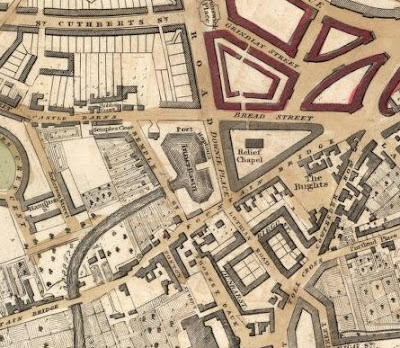He was Robert Downie: he was 41 years old, vastly rich, and he had come home.
Robert Downie's father was a farmer and distiller in Spittaldon, half way between Stirling and the Trossachs: perhaps he was one of the moss lairds who migrated from the Highlands to drain the bog and improve the lands of the Forth Valley. Downie himself undertook a far longer journey to seek his fortune, to India.
 |
| Spittaldon, Menteith, Stirlingshire |
Most of the Edinburgh New Town residents I have studied who made fortunes in India enjoyed an official appointment in the East India Company, courtesy of the patronage of Henry Dundas. Robert Downie had no such privilege. He went to Calcutta, where private 'Houses of Agency' were springing up from the 1780s. They financed ships and plantations, ran banks and insurance, and arranged cargoes and remittances. By 1800 they were so successful that their trade in Bengal eclipsed that of the Company. Downie rose to become a partner in one of these houses, Downie and Maitland, which later metamorphosed into the more well-known Cruttenden, MacKillop and Co.
In 1804, aged 33, He married Mary, 18-year-old daughter of one of the Establishment: Joseph Barnard-Smith, a rising merchant in the East India Company. By the time he returned to Scotland the couple had four daughters, Mary, Georgina, Roberta and Harriet, although Mary died soon after their arrival.
The Downies settled at no.20 Charlotte Square, where in 1814 Mary had a son, also Robert. The residents of Charlotte Square were amongst the wealthiest in Edinburgh, but were notable for their mixed social backgrounds: William Arbuthnot at no.16 was the son of a failed businessman in Aberdeen. Henry Cockburn at no.14, opposite his friend John Tod at 46, came from solid local landed families, and had risen in the legal profession. Next door to the Downies at no.19, Thomas Allan came from a dynasty of Edinburgh bankers. At no.7, with a longer pedigree but a shorter pocket, the clan chief John Lamont of Lamont was on the point of having to sell up, his ancestral wealth unable to keep pace with these beneficiaries of Scotland's economic miracle.
Yet this was before the days when Edinburgh turned in on itself and peeked at its neighbours from behind lace curtains. These first inhabitants of Charlotte Square, many of whom had young children, formed a flourishing community characterised by long and happy marriages, an idealistic belief in their ability to improve their society, and an abundance of good food in informal settings. Picnics in the Pentlands, jaunts to country houses, and suppers at in one another's parlours form (along with politics and civic engagement) the material of their letters. Downie, the mysterious traveller from another world, had arrived in what appears to be history's happiest communities.
Downie threw himself into the Scottish craze for Improvement. Three years after his return, he was chair of the Company which promoted the Telford's Union Line of the canal from Edinburgh to Glasgow, in opposition to the Town Council who were championing an impractical and circuitous 'Upper Line'. The Union Line was ultimately successful, and Downie, the major shareholder, gave his name to the street (Downie Place, now a part of Lothian Road) which looked onto the final port in the canal, Port Hopetoun, which came in under a bridge over Semple Street and filled the area between Semple Street and Lothian Road.
Robert Downie was a religious man, and his philanthropy suggests a certain greatness of heart. He was a major investor in the Episcopal Chapel of St John's which was built in 1818 conveniently between his house in Charlotte Square and his Canal site on Lothian Road, and a member of its first Vestry. On his return from India he had bought the Highland estate of Appin from the Marquis of Tweeddale. Thirty years later, the Presbyterian minister of Appin said of him, 'I do not think that there is a parish in Scotland in which the Episcopalian heritors deserve at the hands of the Establishment more honourable mention'.
 |
| St John's Chapel in 2012: the canal has been superseded as a form of transport by the buses, and the Town Council's latest transport lark, the trams, are under construction. |
Downie had learned Episcopalianism in India, where the Anglican Church predominated. On the mosses of Spittalton he had been brought up a Presbyterian, and one might imagine that he would be eager to erase this lowly past, and remain the mysterious traveller whose history began in India. Yet soon after his return to Scotland he 'presented to the congregation of Norriestown, an elegant service of four silver communion cups, as a tribute of the regard for that religious establishment, which he attended in his youth.'
Downie went on to enter parliament for the Stirling Burghs, and died in 1841. A shrewd businessman yet generous, open-minded yet committed to his beliefs, travelling the world yet attached to places, Robert Downie was one of the people who made Regency Edinburgh such an exciting place to be.
More information and sources are available on Robert Downie's page at The Episcopal Congregation of Charlotte Chapel project website.



No comments:
Post a Comment